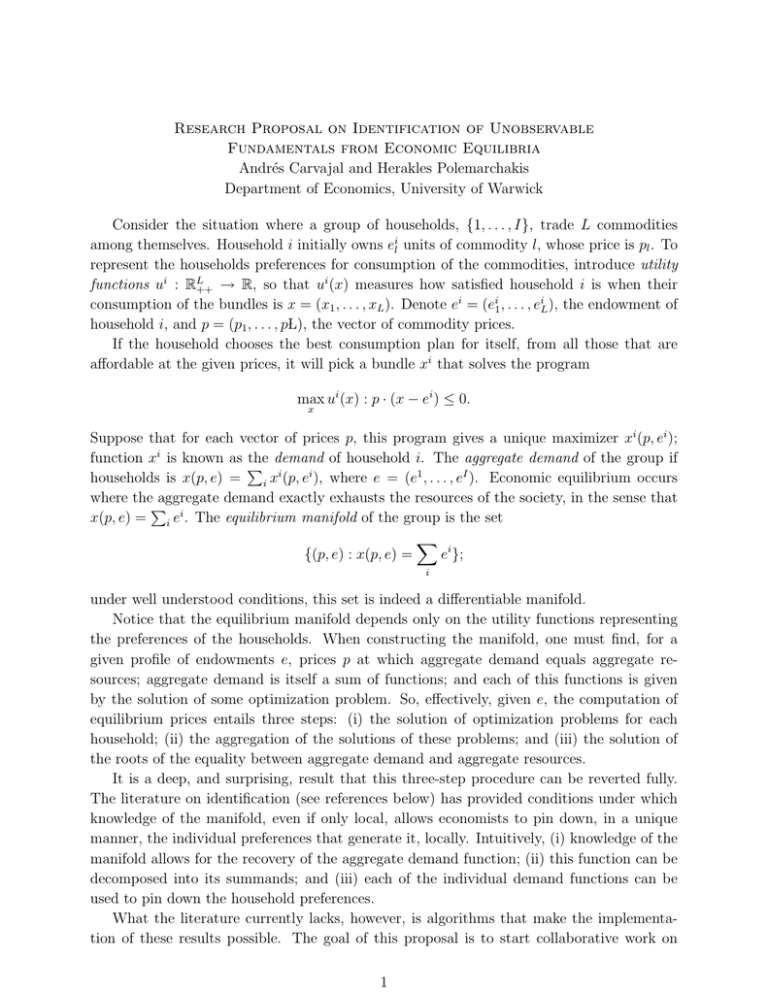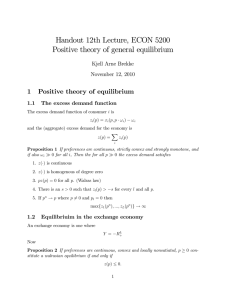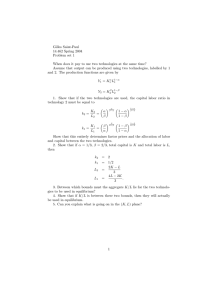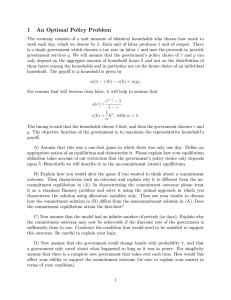Research Proposal on Identification of Unobservable Fundamentals from Economic Equilibria Andr´
advertisement

Research Proposal on Identification of Unobservable
Fundamentals from Economic Equilibria
Andrés Carvajal and Herakles Polemarchakis
Department of Economics, University of Warwick
Consider the situation where a group of households, {1, . . . , I}, trade L commodities
among themselves. Household i initially owns eil units of commodity l, whose price is pl . To
represent the households preferences for consumption of the commodities, introduce utility
functions ui : RL++ → R, so that ui (x) measures how satisfied household i is when their
consumption of the bundles is x = (x1 , . . . , xL ). Denote ei = (ei1 , . . . , eiL ), the endowment of
household i, and p = (p1 , . . . , pL), the vector of commodity prices.
If the household chooses the best consumption plan for itself, from all those that are
affordable at the given prices, it will pick a bundle xi that solves the program
max ui (x) : p · (x − ei ) ≤ 0.
x
Suppose that for each vector of prices p, this program gives a unique maximizer xi (p, ei );
function xi is known as the demand of household i. The aggregate demand of the group if
P
households is x(p, e) = i xi (p, ei ), where e = (e1 , . . . , eI ). Economic equilibrium occurs
where the aggregate demand exactly exhausts the resources of the society, in the sense that
P
x(p, e) = i ei . The equilibrium manifold of the group is the set
X
{(p, e) : x(p, e) =
ei };
i
under well understood conditions, this set is indeed a differentiable manifold.
Notice that the equilibrium manifold depends only on the utility functions representing
the preferences of the households. When constructing the manifold, one must find, for a
given profile of endowments e, prices p at which aggregate demand equals aggregate resources; aggregate demand is itself a sum of functions; and each of this functions is given
by the solution of some optimization problem. So, effectively, given e, the computation of
equilibrium prices entails three steps: (i) the solution of optimization problems for each
household; (ii) the aggregation of the solutions of these problems; and (iii) the solution of
the roots of the equality between aggregate demand and aggregate resources.
It is a deep, and surprising, result that this three-step procedure can be reverted fully.
The literature on identification (see references below) has provided conditions under which
knowledge of the manifold, even if only local, allows economists to pin down, in a unique
manner, the individual preferences that generate it, locally. Intuitively, (i) knowledge of the
manifold allows for the recovery of the aggregate demand function; (ii) this function can be
decomposed into its summands; and (iii) each of the individual demand functions can be
used to pin down the household preferences.
What the literature currently lacks, however, is algorithms that make the implementation of these results possible. The goal of this proposal is to start collaborative work on
1
the development of such algorithms. The related problem of determining whether there
exist preferences that can generate a given set as their equilibrium manifold poses similar
questions, and can generate further research.
We propose to have a series of lectures (by us) delivered to interested students, with the
participation of interested PhD students from the Economics Department, to present the
current understanding in the literature, and to discuss the existing research problems. After
this, we will agree on the research plan for the student(s), who will be jointly supervised,
through weekly meetings.
References:
Carvajal, A., Ray, I. and Snyder, S. , 2004. Equilibrium behavior in markets and games:
testable restrictions and identification. Journal of Mathematical Econonomics 40, 1-40.
Carvajal, A. and Riascos, A., 2005. Identification of preferences from market data.
Advances in Theoretical Economics 5, issue 1, art 3.
Carvajal, A. and Polemarchakis, H., 2008. Identification of Pareto-improving policies:
information as the real invisible hand, Journal of Mathematical Economics 44, 167-179.
Carvajal, A. and Riascos, A., 2008. Identification of individual demands from market
data under uncertainty. The B.E. Journal of Theoretical Economics 8, 1 (Topics), art 9.
Chiappori, P.-A., Ekeland, I., Kübler, F. and Polemarchakis, H., 2002. The identification
of Preferences from Equilibrium Prices. CORE Discussion Paper 2000/24.
Chiappori, P.-A., Ekeland, I., Kübler, F. and Polemarchakis, H., 2004. Testable Implications of General Equilibrium Theory: a differentiable approach. Journal of Mathematical
Econonomics 40, 105-120.
Geanakoplos, J. and Polemarchakis, H., 1990. Observability and Optimality. Journal of
Mathematical Econonomics 19, 153-165.
Kübler, F., Chiappori, P.-A., Ekeland, I., and Polemarchakis, H., 2002. The identification
of Preferences from Equilibrium Prices under Uncertainty. Journal of Economic Theory 102,
403-420.
2








